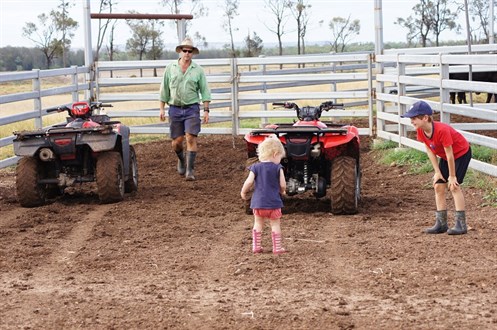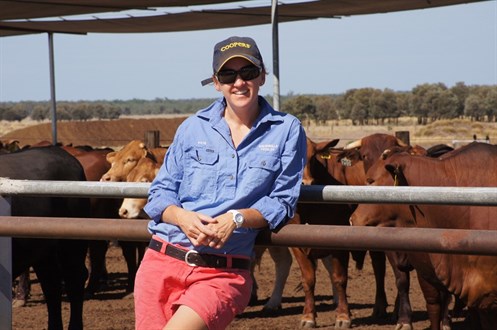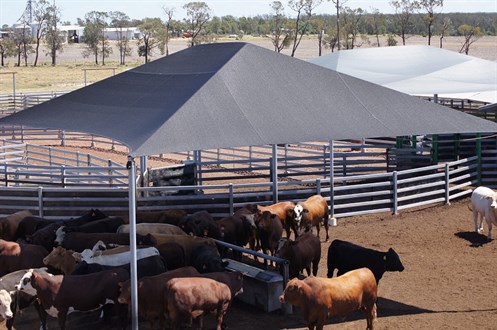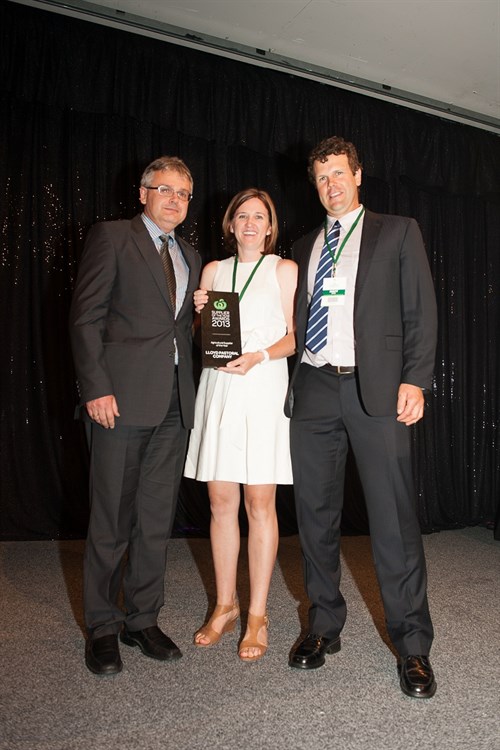In the year of family farming, Col Jackson talks to a dynamic young couple whose wisdom goes beyond their years — and of their determination to work together effectively.
When Katie Lloyd addressed a recent forum in Chinchilla organised by AgriFood Skills Australia as part of the AgriFood National Regional Initiatives, her inspired address gave those present much food for thought.
This was probably one of those times when husband, Scott, was quite happy to stand back while his wife described their feedlotting enterprise that last year earned them the Woolworth’s 2013 Australian Agricultural Supplier of the Year.
Katie’s address set the theme for the day’s forum, especially linking family farming to the future, and there was no sign of fear, although Katie did say from the outset “we are the first to admit that we have an awful lot to learn”.
Katie and Scott operate a 5,000 head feedlot on their mixed farming enterprise ‘Wieambilla’, 30km from Chinchilla. They supply Meat Standards Australia (MSA) grade heifers and steers to the domestic market through the Woolworths supply chain and also onto the export market.
Their individual backgrounds form the basis of their 12 years together. Both were born on the land — Scott in Chinchilla and Katie in Roma. They individually left home to complete their education and later attend university.
Scott undertook a science degree and completed an agribusiness course at Marcus Oldham, which his father insists taught him the art of how to spend money. He returned to the family property in 1997.
“This was indeed essential,” says Katie. “It’s a high cashflow business — the money comes in and the money goes out.”
Katie’s formal education ended with a half-completed degree in journalism “with honours for having a very good time”. She joined Scott in 2002 and took-up a position as a journalist at the local newspaper.
They now have three young children and a large home on their 3,200-hectare property. It is a description in itself of their commitment to family and farm — a dynamic combination when it is considered what two can achieve when working effectively together.
Scott and Katie decided early in their partnership that they needed to strike a balance — they didn’t want to look back and realise they had missed their children’s childhoods simply because they were too caught-up in the day-to-day.
“While we love what we do, and are 100 per cent committed to it, we won’t let our business dictate our lives — and in all honesty, our kids make sure they do the dictating anyway,” Katie admits.
It’s evident Katie is in her element on the farm. It’s a different way of life, a learning curve, a voyage of discovery, and above all, there’s the stand-out pride in what they are achieving.
“For Scott and me, being the biggest and best is not our ambition. We just want to continue doing what we do well, embrace those changes that enhance our industry, all the while meeting consumer expectations, and most importantly [we want to] remain passionate — because, without passion, it’s a tough gig.”
The over-riding factor was the inherent wisdom in Scott’s and Katie’s outlook for their business.
“The family farm is the foundation of Australia’s agricultural industry and it has played, and will continue to play, a pivotal role in our future,” Katie says.
“There’s no question that Australian farmers are good at what they do, and in this international year of family farming I think we all need to reflect on the amazing abilities of our people and the capabilities of our land.
Katie Lloyd
“There’s no doubt a lot can be learned from the past, but the future is where we’re headed, and it’s imperative we don’t limit ourselves simply because of the unknown,” Katie admits.
Here they acknowledge their ‘other family’ among the key relationships that are most critical to their success. They realise retaining staff is extremely important; continuity and experience is a valuable asset, and to date, they have been extremely fortunate in this area.
“Our staff is instrumental in ensuring we are physically getting the job done each day. They have a huge responsibility in the health, welfare and feeding of our livestock — all critical components of a lot feeding enterprise.
“We have a huge respect for the work they do, knowing we couldn’t do it alone, and like to consider ourselves as fair and reasonable employers. We are flexible, we pay our staff well and we respect they have lives too — they have families and other interests, and we work with them to ensure they are getting the balance right too.
“We want our staff to value their roles, help us to continue improving the way we operate and to know they are making a valuable contribution to our business.”
When initially asked to talk about their business success, Scott and Katie were extremely hesitant.
“We had never really considered ourselves as successful business operators, moreso passionate ones, and we couldn’t help but question what we had to offer our peers,” Katies says.
Alternatively, when they considered their achievements — especially the Woolworths Award — they agreed theirs was a story to tell.
Central to the business is a 5,000-head feedlot that turns-off 20,000 head annually into both domestic and export markets. Approximately 70 per cent (forward orders of 320 head per week) goes to Brismeat’s Churchill abattoir; this represents about 10 per cent of the Woolworths’ weekly kill.
Cattle are generally sold on forward contracts, which greatly assist in long-term planning and outlook. Knowing what’s going out at a fixed price in turn helps establish cattle purchasing requirements while also offering cashflow certainty.
“Our relationship with both Woolworths and Kilcoy are ones we don’t take for granted. We have been proud suppliers of Woolworths since the late 1980s, and continuing this is paramount going forward,” Scott says.
“While many breeds of cattle can go on to grade and meet MSA criteria, we are looking for softer British bred types, which further suit the Woolworths market. With an incoming weight range of 300kg to 370kg, these cattle will exit at 500kg seeking a target carcass weight of 270kg.
“We are also feeding these cattle for an extra 10 days, meaning steers usually do a minimum of 80 days on feed, while heifers average 70 to 75 days. We believe this move has resulted in a higher quality finish, which is reflected on both the hoof and the hook, and we’re certain we are supplying a better animal today than what we were a few years ago.”
The 100-day cattle go to Kilcoy and the 120-day goes to the export market. Some consignments of cattle also go to Teys Brothers, JBS Swift and Oakey Holdings.
Sourcing cattle to meet their requirements is entrusted to five buyers who act on their behalf.
“Buyers, agents and producers must realise that we are simply meeting a market, not driving it,” Scott says. “While I’d like to say we don’t get out-of-spec cattle, we do. It’s costly, it’s something we are continually working to eliminate and probably something we will still be harping on about in years to come.
“However, on the whole our cattle are performing well.”
To maintain proper nutrition across the feedlot, both summer and winter crops are grown on the property to supplement the annual fodder requirements, while the balance of the country is used to background cattle prior to feedlot entry.
“We take pride in our industry and remain passionate about producing quality beef in accordance with national guidelines and standards,” Katie says.
“Environmental sustainability and animal welfare are two issues of significant importance to us as landholders and beef producers.”
Katie and Scott also understand the market.
“Consumers are becoming increasingly aware of their food and its origin and, as food producers, we have to embrace trends and meet expectations,” Katie says.
“Scott and I respect this and don’t fear it, because we too care about what we eat, its sustainability and the environment on which it is grown.”
Then there are the challenges.
“We have battled succession planning, we’ve experienced two of the largest flood events ever recorded over a two-year period, we have been struggling with the development of the coal seam gas industry on our land and, to our credit, we have survived both a challenging period in the lot feeding sector and the wider global financial situation experienced over the past few years,” Katie says.
“But it hasn’t all been bad.”
She says they were fortunate to succeed his parents in a very productive and well established business, and had the benefit of their hands-on experience and knowledge of both the property and the industry, to guide them.
“They have more than 30 years’ invaluable experience in feedlotting, and we are determined to build on this success in our own way.
“Succession planning is an extremely tough process for all involved, and it’s an issue many farming families are today dealing with.
“Unfortunately, to reach an outcome you need to discuss the difficult topics — and this has to be done openly and honestly,” Katie says.
She says communication and starting the process early is what they believe is the key.
“If we want to preserve the future of farming families, then succession planning is a vital component.”
After Scott’s return to Wieambilla in ’97, he was determined to drive the business forward. He could see the potential for expansion and was sure things could be done more efficiently, but naturally this comes at a cost and ignited some very good inter-generational debate.
“Some of these major developments included expanding the feedlot by 2,000 head, installing a road train weighbridge to validate all incoming cattle and fodder weights, implementing a bulk management feeding system to record and manage fodder consumption, re-building silage pits to increase capacity to provide further insurance for the dry years, improving watering points to grazing paddocks — and the biggest investment, and definitely the biggest game changer, was the construction of a new feed mill complex on a greenfield site,” Katie says.
She says the complex system — completed in 2008 — has transformed the day-to-day role of feeding cattle. It replaced an inefficient structure that had simply been outgrown, and has been instrumental in their success, “as well as giving us a life”.
No more do they mill grain 14 hours a day.
Maintenance is another key factor.
“We have budgeted and accounted for this, and accept that it is our reality if we want to remain efficient, profitable in the long-term” Katie says.
She says the investment strategy has produced debt, and while that’s not their long-term objective, it is an essential adversary that drives them forward.
Efficiency is one of the keys in their business plan, and not just for the benefit of profitability. Running a feedlot is constant; cattle are fed 365 days a year rain, hail or shine. Balancing that with family is hard work and is one of Katie and Scott’s biggest challenges.
Katie acknowledges the ‘behind the scenes’ support that allows them to operate efficiently and profitably.
“We believe it’s imperative to have a great team of advisors to bounce ideas around. Our accountants and our bank managers have been instrumental in getting our heads around budgeting, cashflows and how to best manage finances, and I have a great bookkeeper who supports me with the day-to-day,” she says.
She says learning to manage a large cashflow business has been interesting, challenging, rewarding and some days, just plain hard.
Being named the 2013 Woolworths Agricultural Supplier of the Year was certainly unexpected, yet a significant honour that Katie and Scott are extremely proud of.
“It is terribly reassuring for two young people who are constantly reviewing and assessing the way they do things to know they must be doing something right,” Katie says.
“We didn’t win that award alone — it is the hard work of many.
“It hasn’t changed anything on the ground, but it has certainly boosted our confidence and given us incentive to continue with our plans.”
But it doesn’t stop there.
“There are further upgrades to the livestock management structure to allow more effective control over individual animals. Then there is a weather station planned to monitor on-site conditions and provide data to help prepare for any major climatic variation.”
Scott says bigger plans include expanding the feedlot to provide for more space to accommodate a longer feeding regime for the Woolworths cattle.
“We are also keen to explore ways to better manage our grazing country and, when financially confident, we would like to develop a current river licence to add diversity to our crop production capabilities.”
He says there are certainly some external challenges that need to be considered when operating in a high cost environment where it’s becoming increasingly difficult to make a sustainable return.
“We operate with very little financial support from government, and there’s no doubt more can be done to preserve our agricultural industries, and their viability, going forward,” Scott says.
He says the agricultural industry has a hard job ahead convincing consumers to value the work of Australian farmers and buy local goods because, without their support, “our market share is reduced and we go out of business”.
However, Katie and Scott remain confident in its future and have faith that Australia’s high production standards will provide a continued demand.
“Family farms are pivotal in this equation and we must remain positive, united and committed to the job at hand.”
Photography: Col Jackson







